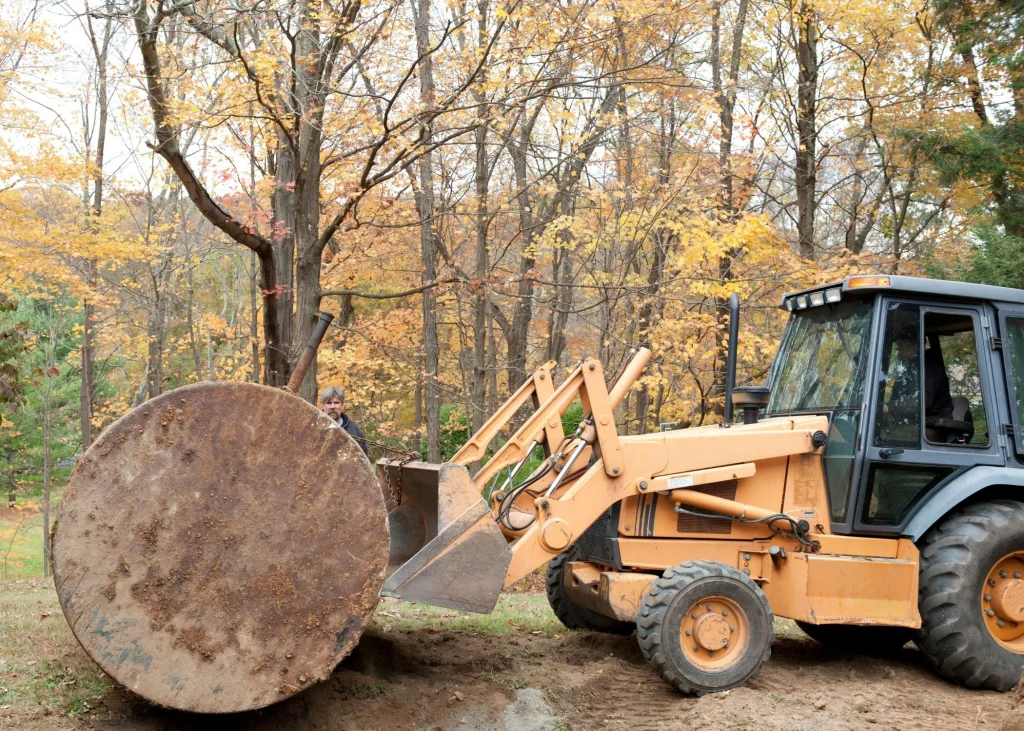- Home
- Oil Tank Removal
Oil Tank Removal
Your Backyard
Since 2000, Robinson Landscape has steadily grown into a trusted and successful company because of our highly professional work, attention to detail, and outstanding customer service. Contact Us Today!
Professional Oil Tank Removal in Bucks County & Southeastern PA
Oil tank removal in Bucks County is a critical environmental and safety service that protects your property from contamination and costly cleanup. Robinson Landscape, a licensed and OSHA-certified contractor serving Southeastern Pennsylvania and New Jersey since 2000, specializes in safe, efficient underground and aboveground oil tank removal for residential and commercial properties. With over 25 years of experience, owner Tim Robinson and his expert team handle every aspect of oil tank removal—from initial assessment and permit acquisition to complete excavation, disposal, and site restoration—ensuring your property remains safe, compliant, and ready for its next chapter.
Aging oil tanks pose serious risks to Bucks County and Montgomery County homeowners. As steel tanks corrode over time, they can leak heating oil into soil and groundwater, creating environmental hazards that cost tens of thousands of dollars to remediate. Whether you’re converting to natural gas, selling your home, or addressing a deteriorating tank, professional oil tank removal eliminates these risks while increasing property value and peace of mind.
What You Need to Know About Oil Tank Removal
What
- Professional removal of underground storage tanks (USTs) and aboveground storage tanks (ASTs) that previously stored heating oil, diesel, or other petroleum products. The service includes tank excavation, disposal, soil testing, site restoration, and regulatory compliance.
Where
- Robinson Landscape serves all of Bucks County, Montgomery County, Southeastern Pennsylvania, Central New Jersey, and South Jersey—including Doylestown, Newtown, Warminster, Buckingham, Lansdale, Horsham, Abington, and surrounding communities.
Who
- Homeowners converting heating systems, property sellers addressing inspection issues, buyers discovering old tanks, estate executors managing inherited properties, and commercial property owners maintaining compliance.
When
- Immediate removal is recommended for tanks over 30 years old, leaking tanks, abandoned tanks during heating system conversions, pre-sale property preparations, and whenever soil contamination is suspected.
Why
- Prevent environmental contamination, eliminate liability, satisfy mortgage and insurance requirements, increase property value, enable safe property development, and achieve peace of mind knowing your property is safe.
How
- Licensed professionals assess the tank, secure necessary permits, excavate safely around the tank, properly dispose of contents and tank material, test soil for contamination, restore the site with proper grading and fill, and provide documentation for future property transactions.
Investment
- Project-based pricing determined by tank size, location, accessibility, soil conditions, and potential contamination. Robinson Landscape provides transparent, detailed estimates after free on-site consultation—no hidden fees or surprises.
Contact Robinson Landscape Today!
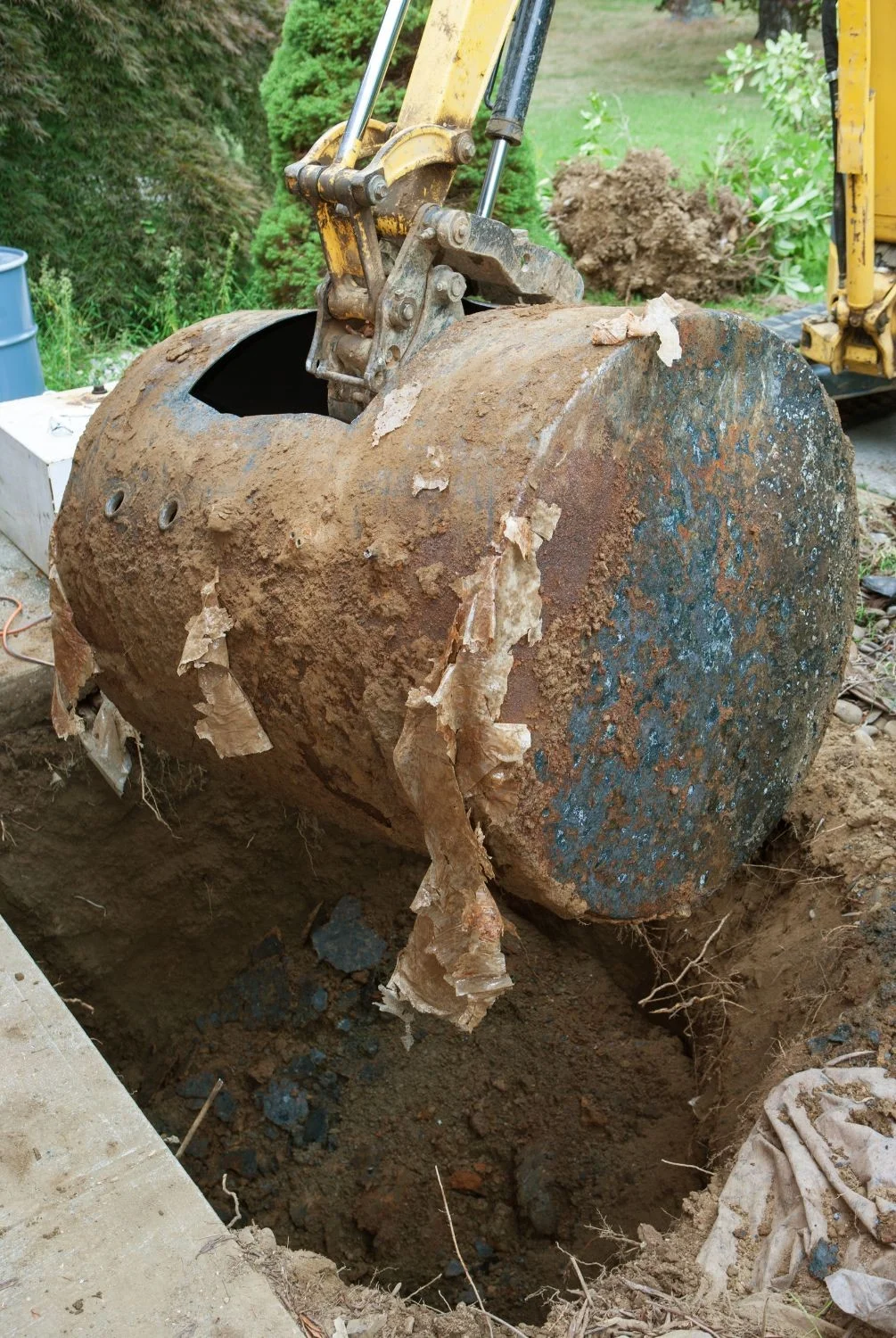
Comprehensive Oil Tank Removal Services
Understanding Oil Tank Removal
Oil tank removal is far more complex than simply digging up old metal. In our 25 years serving Southeastern Pennsylvania, we’ve seen every scenario—from straightforward removals to complicated situations involving soil contamination, difficult access, and unexpected underground obstacles. Professional oil tank removal requires specialized equipment, environmental expertise, regulatory knowledge, and meticulous attention to safety protocols.
What's Included in Professional Oil Tank Removal
Our comprehensive service covers every aspect of your oil tank removal project from start to finish
- We begin with a thorough on-site assessment where we locate the tank, evaluate its condition, assess accessibility, and identify potential complications. This initial evaluation allows us to provide an accurate estimate and project timeline.
Permit acquisition and regulatory compliance come next
- Pennsylvania and New Jersey require specific permits for oil tank removal, and requirements vary by municipality. We handle all paperwork, coordinate with local authorities, and ensure every aspect of your project meets or exceeds regulatory standards. This eliminates stress and delays for property owners.
The excavation phase requires precision and care
- We carefully expose the tank, protecting surrounding structures, utilities, and landscaping. Our experienced crew uses proper safety barriers and equipment to secure the work area. We safely pump out any remaining contents, following environmental protocols for petroleum product handling.
Tank removal and disposal follow strict environmental guidelines
- We cut the tank into manageable sections when necessary, transport all materials to approved recycling or disposal facilities, and provide complete documentation for your records. Proper disposal protects you from future liability.
Soil testing is a critical component many contractors overlook
- We collect soil samples from around the tank location and beneath where the tank sat. Laboratory analysis determines if contamination exists. If soil contamination is present, we provide guidance on remediation options and can coordinate cleanup services.
Site restoration returns your property to beautiful, usable condition
- We backfill the excavation with clean fill material, grade the area to prevent settling and drainage issues, compact soil properly to prevent future subsidence, and restore landscaping with topsoil and seed. The result is a site that's ready for your next project—whether that's a new garden, patio, driveway, or simply a restored lawn.
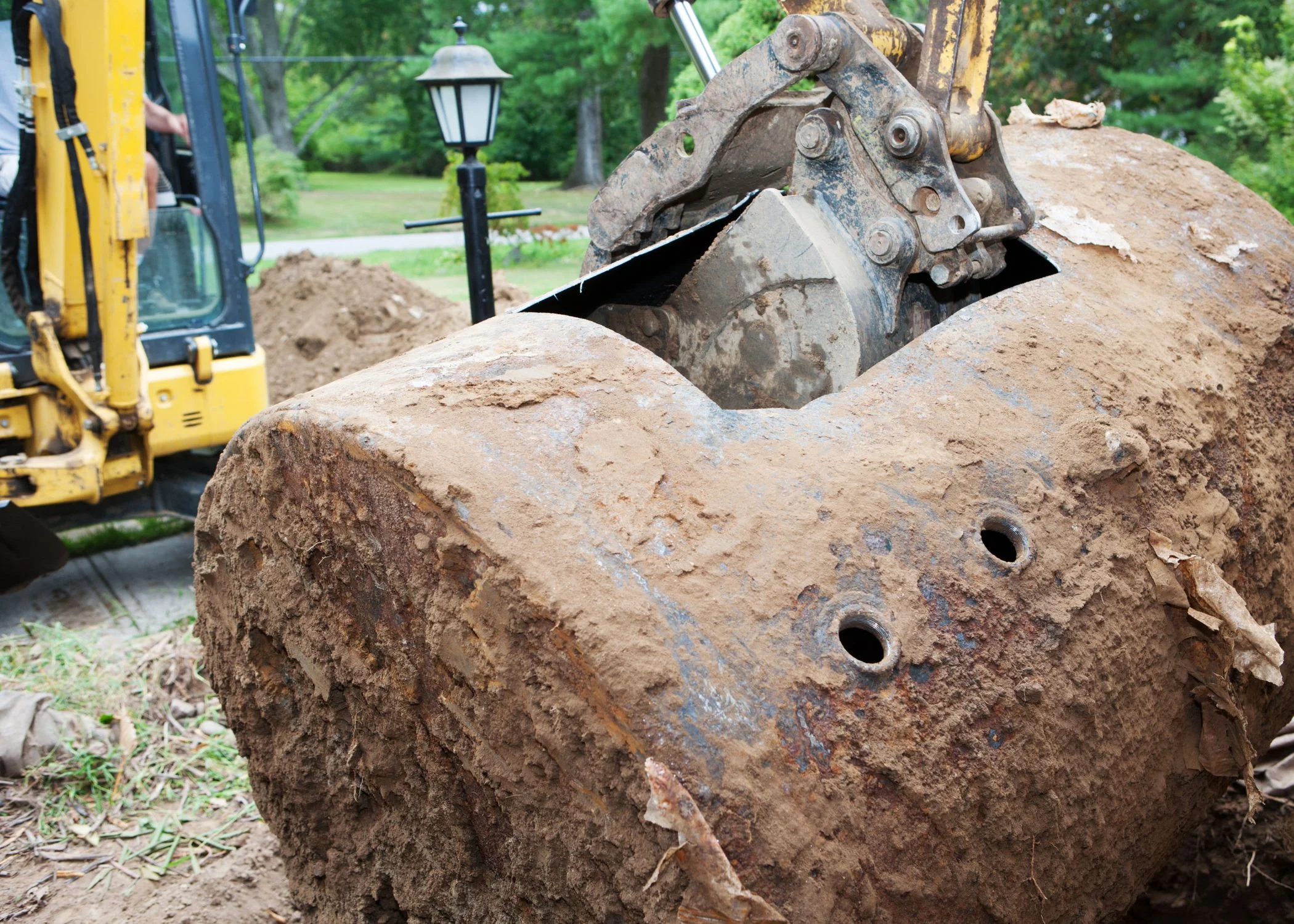
What's NOT Included (But We Can Help With)
While our standard service is comprehensive, some situations require additional services. Major soil remediation for extensive contamination typically involves environmental specialists, though we coordinate these efforts. Interior plumbing modifications for heating system conversions are handled by licensed plumbers, but we can provide referrals. New heating system installation requires HVAC contractors, though our work prepares your property perfectly for this next step.
Types of Oil Tanks We Remove
Underground Storage Tanks (USTs)
Underground tanks present the greatest risk and the most complex removal challenges. These tanks, typically buried 2-4 feet below ground, are invisible threats that deteriorate over time. Bucks County and Montgomery County properties built before 1980 often have underground heating oil tanks that have been abandoned or forgotten.
We've successfully removed hundreds of underground tanks ranging from 275 gallons to 1,000+ gallons. Common locations include front yards, side yards, beneath driveways, and near building foundations. Our excavation techniques protect your property while ensuring complete tank removal. We understand Pennsylvania's soil conditions, from the clay soils common in Bucks County to the rockier terrain in parts of Montgomery County.
Aboveground Storage Tanks (ASTs)
Aboveground tanks in basements, garages, or outdoor installations also require professional removal. While generally simpler than underground removal, basement tank removal presents unique challenges—particularly getting large tanks through doorways and up stairs. We've developed techniques for safe indoor tank removal that protect your home's interior.
Exterior aboveground tanks on concrete pads or steel stands also need proper removal and disposal. We remove the entire system, including supports, piping, and concrete pads if desired, leaving a clean site ready for your next use.
Abandoned and Orphan Tanks
Many Northeastern Pennsylvania properties have "orphan" tanks—abandoned by previous owners when heating systems were converted. These forgotten tanks pose the greatest liability because owners often don't know they exist until property inspections reveal them. We've removed countless orphan tanks discovered during real estate transactions, estate settlements, and renovation projects.
Why Bucks County & Montgomery County Choose Robinson Landscape
25+ Years of Local Oil Tank Removal Expertise
Since 2000, Robinson Landscape has been Southeastern Pennsylvania's trusted partner for oil tank removal. Tim Robinson founded our company with a commitment to environmental responsibility and customer satisfaction that remains our foundation today. Over 25 years, we've removed thousands of oil tanks across Bucks County, Montgomery County, and throughout the region.
Our longevity means we understand local conditions other contractors miss. We know Pennsylvania's freeze-thaw cycles affect tank deterioration. We're familiar with the specific regulations in Doylestown, Warminster, Horsham, and every municipality we serve. We've worked with every local inspector and environmental official, building relationships that streamline your project.
Local Market Knowledge That Matters
Bucks County and Montgomery County have unique characteristics that impact oil tank removal. Many properties in established neighborhoods like Newtown, Buckingham, and Abington were built when heating oil was the standard fuel. These homes often have underground tanks that have been in place for 40-60 years—well beyond their safe lifespan.
We understand local property values and real estate market expectations. In competitive markets like Doylestown and Lansdale, unaddressed oil tanks can derail sales or reduce offers by tens of thousands of dollars. Our efficient removal process—typically completed in 2-3 days—keeps real estate transactions on schedule.
Soil conditions vary significantly across our service area. The heavy clay soils common in lower Bucks County require different excavation approaches than the sandier soils found in parts of Montgomery County. We adjust our techniques based on actual site conditions, preventing complications that less experienced contractors encounter.
Comprehensive Licensing and Environmental Credentials
Robinson Landscape maintains all required licenses and certifications for oil tank removal in Pennsylvania and New Jersey:
Pennsylvania License PA071368
Current contractor license demonstrating compliance with state requirements
New Jersey License 13vh08112100
Full authorization for work throughout New Jersey
Philadelphia License #46245
City-specific licensing for Philadelphia County properties
OSHA Certification #36-900440038
Workplace safety certification protecting our crew and your property
These credentials aren’t just paperwork—they represent our commitment to professional standards and your protection. Licensed contractors carry proper insurance, follow safety protocols, and provide recourse if issues arise. When you hire Robinson Landscape, you’re protected by comprehensive liability coverage and workers’ compensation insurance.
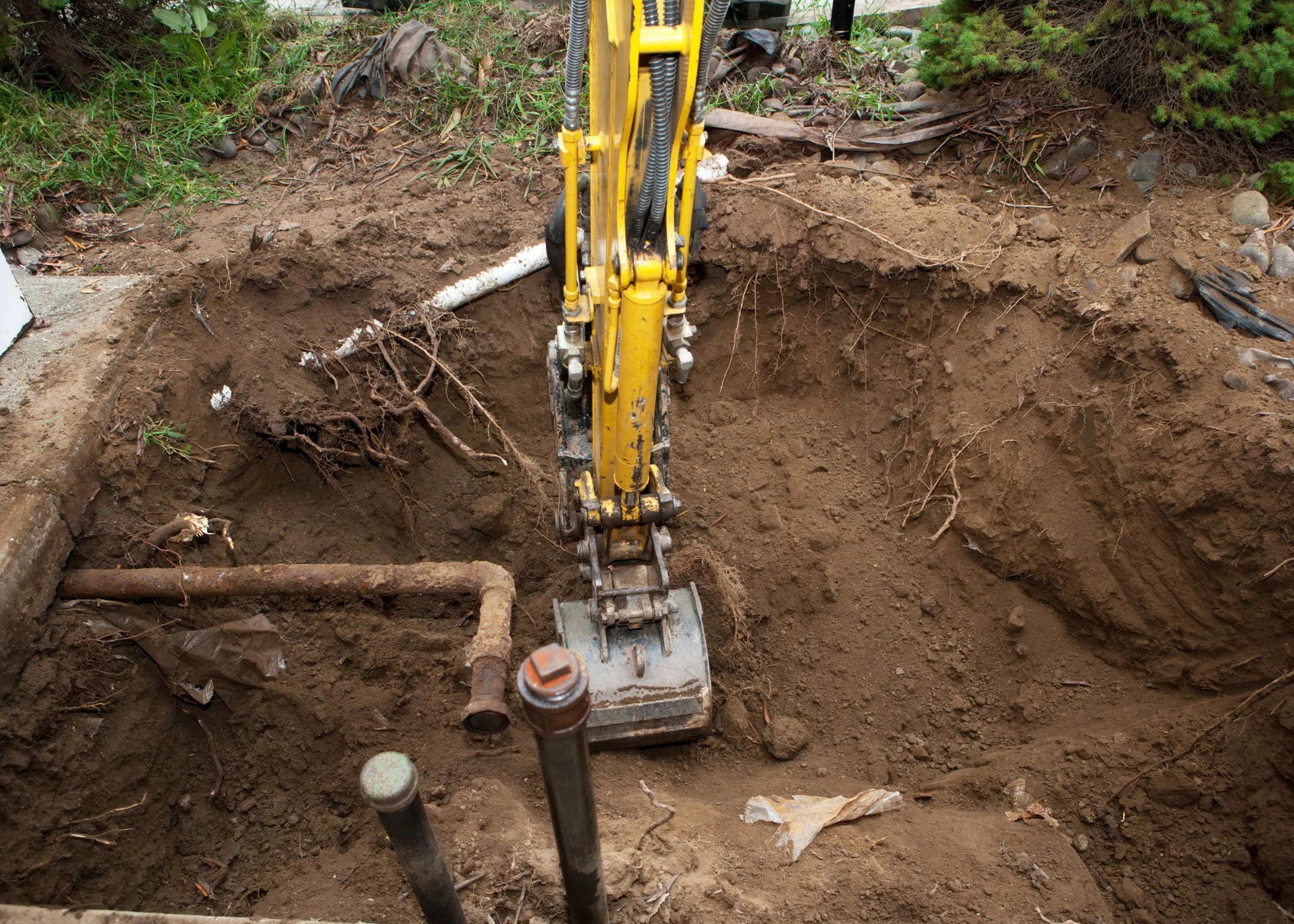
Environmental Responsibility and Community Commitment
Environmental stewardship drives everything we do. We’ve witnessed firsthand the damage oil leaks cause to Southeastern Pennsylvania’s soil and groundwater. Our removal methods exceed regulatory requirements because we’re protecting the community where we live and work.
We recycle metal tanks whenever possible, diverting thousands of pounds of steel from landfills. Our disposal partners are carefully vetted, ensuring petroleum products and contaminated materials reach approved facilities. We provide complete documentation so you have a clear environmental record for your property.
Robinson Landscape is more than a contractor—we’re your neighbors. We’re active in local business communities, support area initiatives, and build our reputation one satisfied customer at a time. When you see our trucks around Bucks County and Montgomery County, you’re seeing a company that cares about this region’s environmental future.
Our Proven Oil Tank Removal Process
Step 1
Free On-Site Consultation and Assessment
Your oil tank removal project begins with a thorough, no-obligation consultation. Tim Robinson or a senior team member visits your property to evaluate your specific situation. This isn’t a quick glance—we spend time understanding your needs, answering questions, and developing the right removal strategy.
During assessment, we locate the tank precisely (using property records, ground-penetrating radar if needed, or visual inspection for aboveground tanks). We evaluate tank accessibility and potential obstacles like utilities, landscaping, driveways, and structures. We assess soil conditions and property grades that affect excavation. We discuss your timeline, concerns, and plans for the space after removal.
This consultation allows us to provide an accurate, detailed written estimate with transparent pricing. You’ll know exactly what to expect—no surprises, no hidden fees. Most property owners find our estimates competitive and our explanations clear and honest.
Step 2
Permit Acquisition and Utility Coordination
Once you approve our estimate, we handle all permitting and coordination. Pennsylvania and New Jersey municipalities have different requirements, and we know them all. We prepare and submit permit applications, coordinate with building departments and environmental agencies, and schedule required inspections.
Utility location is critical for safety. We contact PA One Call or NJ One Call to mark underground utilities before excavation begins. This protects electric, gas, water, sewer, cable, and phone lines. We also verify the location of private utilities like septic systems, irrigation lines, and propane tanks that aren’t marked by public utility companies.
This coordination typically takes 1-2 weeks depending on municipal response times. We keep you informed throughout, providing updates on permit status and anticipated start dates.
Step 3
Safe Excavation and Tank Exposure
Excavation day arrives with our experienced crew and specialized equipment. We establish safety barriers around the work area, protecting your family, neighbors, and our team. Our compact excavation equipment accesses tight spaces while minimizing property disruption.
We excavate carefully, exposing the tank gradually to avoid damage that could cause spills. As we dig, we continuously monitor for any signs of leakage or soil contamination. If we encounter unexpected conditions—like a tank in worse condition than anticipated or evidence of past leaks—we stop, assess, and discuss options with you before proceeding.
For basement tanks, we create protected pathways through your home using floor coverings and wall protection. We measure openings carefully and plan tank removal to prevent interior damage. Our crew treats your property with respect—the same care we’d want in our own homes.
Step 4
Tank Pumping and Content Disposal
Before tank removal, we must safely remove any remaining contents. Even “empty” tanks typically contain residual sludge—a mixture of oil, water, and sediment that accumulates over years. This material must be pumped out and disposed of properly.
We use specialized vacuum equipment to remove all liquids and sludge. This petroleum waste goes to approved disposal facilities that handle it according to environmental regulations. We provide documentation of proper disposal for your records—important protection if environmental questions arise during future property transactions.
Step 5
Tank Removal and Recycling
With contents removed, we extract the tank from the ground or building. Underground tanks are carefully lifted out intact when possible, minimizing soil disturbance. Larger tanks may be cut into sections for safer removal—we make this decision based on tank condition and site constraints.
Aboveground tanks are disconnected from all piping, carefully maneuvered through buildings if necessary, and transported to our trucks. We remove all associated equipment including fill pipes, vent pipes, gauges, and concrete pads or support structures.
Metal tanks are transported to scrap metal recycling facilities whenever possible. This environmentally responsible approach diverts materials from landfills while reducing project costs. Fiberglass tanks and non-recyclable components go to approved disposal facilities.
Step 6
Soil Testing and Environmental Assessment
Soil testing is where we go beyond many competitors. We collect multiple soil samples from locations around and beneath where the tank sat. These samples go to certified environmental laboratories for petroleum hydrocarbon analysis.
Testing typically takes 1-2 weeks for results. Clean soil test results provide peace of mind and valuable documentation for property sales. If contamination is detected, we explain the findings, discuss remediation options, and can coordinate cleanup services with environmental specialists.
Many property owners skip soil testing to save costs—a decision that can backfire during property sales when buyers’ environmental inspections discover contamination. Our thorough testing approach protects your investment and prevents future surprises.
Step 7
Site Restoration and Landscaping
The final phase transforms the excavation site back into usable property. We backfill the hole with clean fill material, compacting in layers to prevent future settling. Proper compaction is crucial—poorly compacted fill leads to depressions and drainage problems months or years later.
We grade the area to match surrounding terrain and ensure proper water drainage away from buildings. The final layer uses quality topsoil, creating an ideal base for grass growth. We hydroseed or seed the area, providing instructions for watering and care to establish a healthy lawn.
For properties with special restoration needs—like matching existing gardens, installing gravel driveways, or preparing for hardscaping—we coordinate these enhancements. Our goal is leaving your property looking better than when we arrived.
Step 8
Documentation and Final Inspection
Before we consider the project complete, we conduct a thorough final inspection with you. We review the restored site, answer any remaining questions, and ensure you’re completely satisfied with the results.
We provide comprehensive documentation including copies of permits and inspection approvals, soil test results and laboratory reports, disposal receipts for tank and contents, before and after photographs, and a detailed invoice. This documentation package is invaluable for property sales, refinancing, or future reference.
Many municipalities require final inspections by building or environmental officials. We coordinate these inspections and ensure your project receives official approval and closure.
Oil Tank Removal Throughout Southeastern Pennsylvania
Robinson Landscape proudly serves an extensive service area across Southeastern Pennsylvania and New Jersey. Our local expertise ensures we understand regional regulations, soil conditions, and market expectations specific to your community.
Bucks County Communities
Doylestown, Newtown, Warminster, Bensalem, Buckingham, Lower Southampton, Hilltown, Northampton, Bedminster, Richland, Quakertown, Perkasie, Sellersville, Chalfont, New Hope, Yardley, Langhorne, Levittown, Bristol and surrounding townships throughout Bucks County.
Montgomery County Communities
Lansdale, Horsham, Abington, Cheltenham, Upper Dublin, Lower Moreland, Lower Providence, Upper Gwynedd, Norristown, King of Prussia, Plymouth Meeting, Ambler, Jenkintown, Willow Grove, Hatboro, Blue Bell, Fort Washington, and surrounding Montgomery County areas.
Additional Service Areas
We extend professional oil tank removal services throughout Southeastern Pennsylvania including Delaware County, Chester County, and Philadelphia County. Our New Jersey service area includes Central and South Jersey communities such as Hamilton, Hopewell, Haddon Township, Mount Laurel, Cherry Hill, and surrounding areas.
Local Expertise for Every Community
Whether you’re in Doylestown’s historic neighborhoods with century-old properties, Warminster’s post-war subdivisions, or Horsham’s established communities, we understand your area’s unique characteristics. We’re familiar with local soil conditions, municipal requirements, and inspector expectations. This local knowledge translates to smoother projects and better outcomes for you.
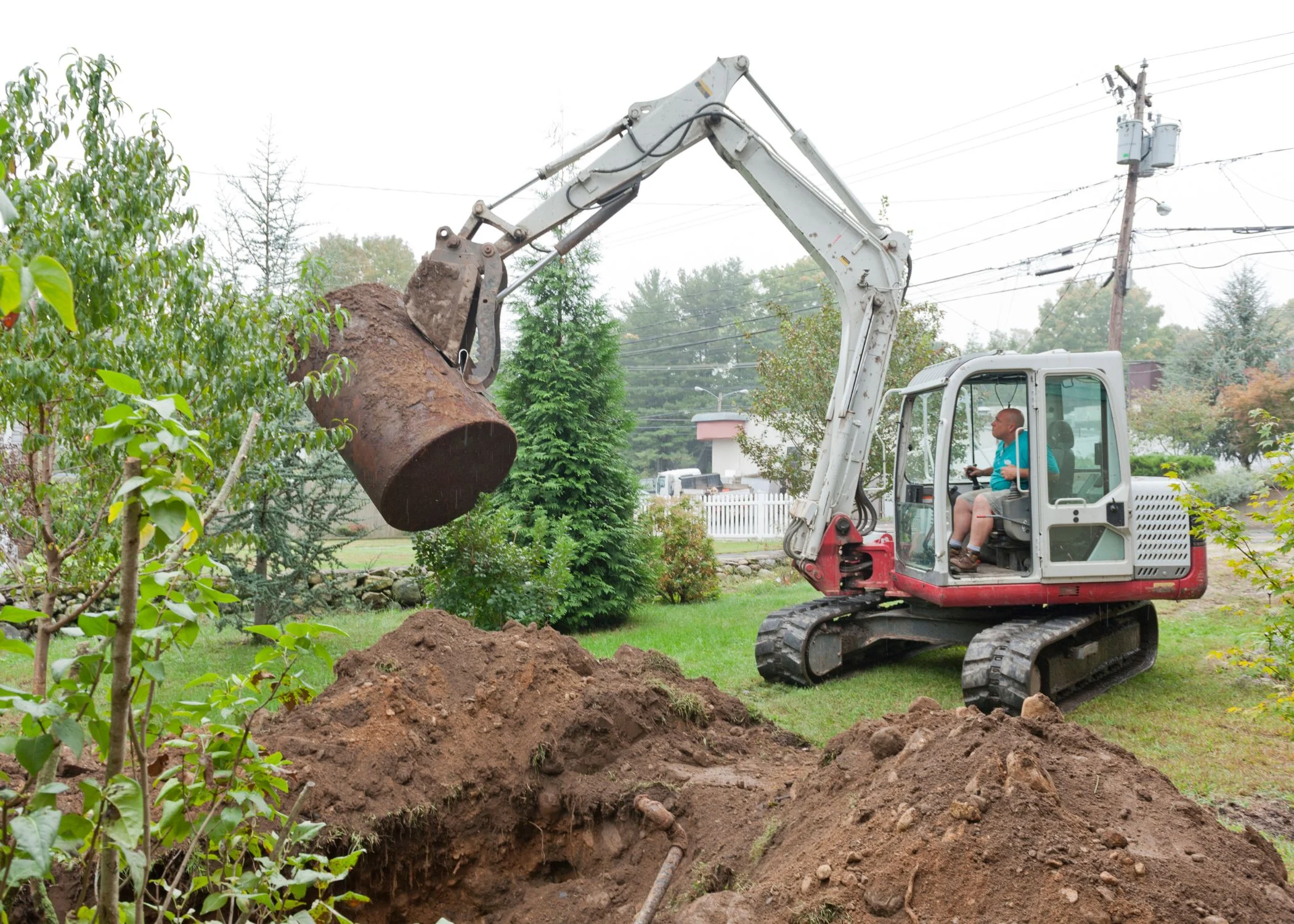
Investment and Value
Transparent, Project-Based Pricing
Every oil tank removal project is unique, and honest contractors provide pricing based on your specific situation—not generic quotes that change when work begins. Robinson Landscape offers transparent, detailed estimates after evaluating your property.
Factors Affecting Oil Tank Removal Cost
Tank size and type significantly impact project scope
A 275-gallon basement tank requires less excavation than a 1,000-gallon underground tank. Accessibility and site conditions affect equipment needs and labor. A tank beneath a driveway requires driveway removal and restoration, increasing project complexity.
Depth and soil conditions matter
Deeper tanks require more excavation, and rocky or clay soils slow progress compared to sandy soils. Contamination levels affect disposal costs—clean tanks cost less to dispose of than heavily contaminated tanks requiring special handling.
Permit requirements vary by municipality
Some communities have straightforward permitting; others require environmental assessments or specialized documentation. We include all permit costs in our estimates so you know the true project investment.
Restoration requirements depend on your goals
Basic lawn restoration costs less than elaborate landscaping or hardscaping installations. We tailor restoration to your needs and budget.
The Value of Professional Oil Tank Removal
Professional oil tank removal is an investment in your property’s safety, value, and your peace of mind. Consider what you’re gaining:
Environmental Protection
- Professional removal prevents soil and groundwater contamination that could cost $50,000-$200,000+ to remediate. We've seen property owners face devastating cleanup costs because they delayed removal or attempted DIY approaches.
Liability Elimination
- Old oil tanks are liability time bombs. Leaks can contaminate neighboring properties, leading to lawsuits and environmental claims. Professional removal with proper documentation eliminates this risk.
Property Value Enhancement
- Homes with documented oil tank removal sell faster and for higher prices than properties with tank concerns. In competitive markets like Bucks County and Montgomery County, clean environmental records are selling points.
Transaction Enablement
- Most mortgage lenders and insurance companies won't approve properties with aging oil tanks or unresolved environmental concerns. Professional removal keeps real estate transactions on track.
Future Development Opportunity
- Removing oil tanks opens possibilities for home additions, pools, garages, and landscaping projects that couldn't proceed with underground obstructions.
Contact Us!
- Free estimates available - Call (215) 292-6572 or email tim@robinsonlandscape.com
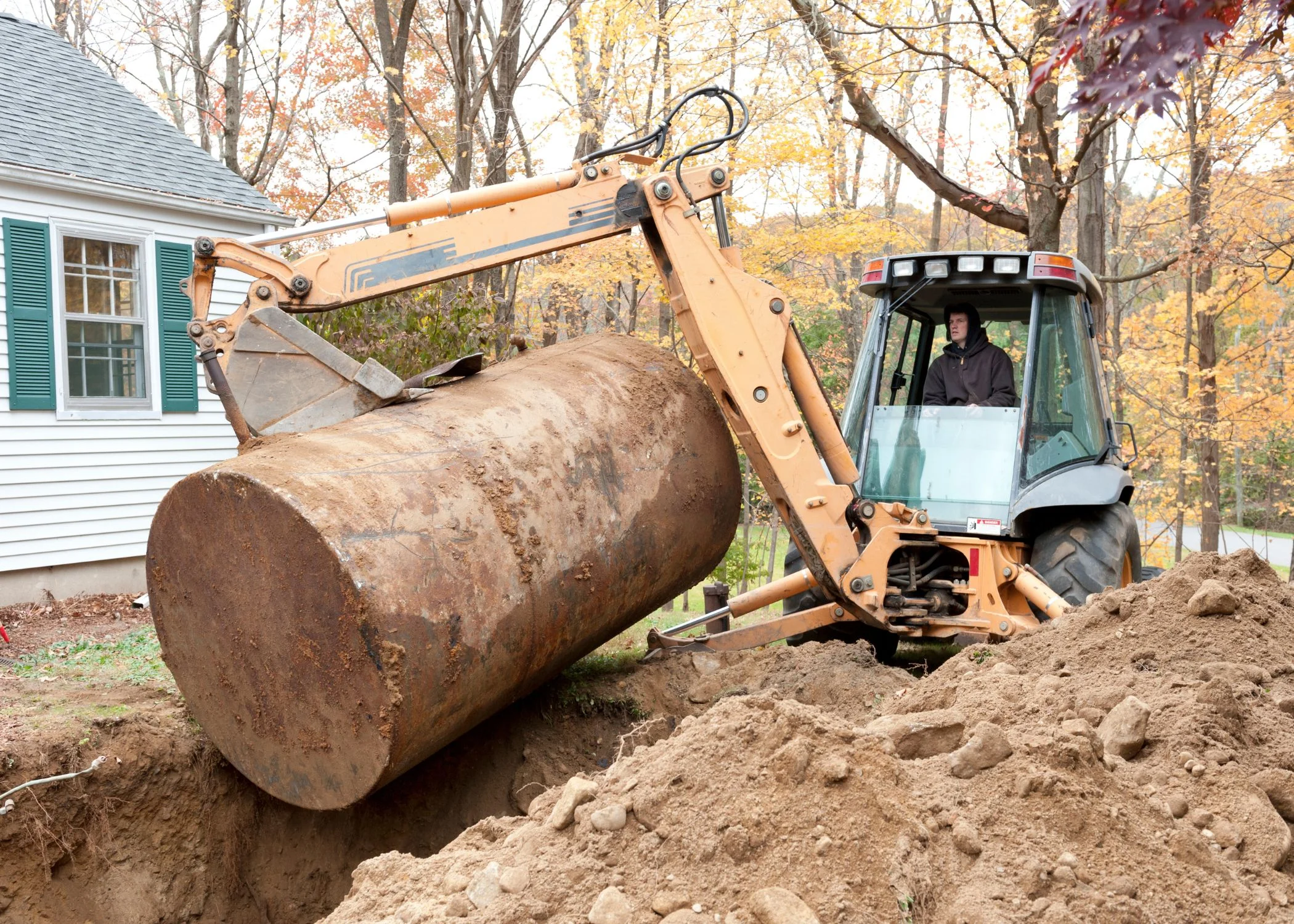
Free Consultation and Detailed Estimates
Robinson Landscape provides free on-site consultations with detailed written estimates. Tim Robinson or a senior team member personally evaluates your project, answers questions, and develops a removal strategy tailored to your situation.
Our estimates include itemized breakdowns of excavation and tank removal, disposal and recycling costs, soil testing and analysis, permit fees and inspection costs, site restoration and landscaping, and project timeline. You’ll know exactly what you’re paying for before work begins—no surprises, no hidden fees.
We stand behind our estimates. If we encounter unexpected conditions, we discuss options with you before proceeding. Our goal is building trust through transparency and delivering value through quality work.
Frequently Asked Questions About Oil Tank Removal
Many Bucks County and Montgomery County homeowners don't know if their property has an underground tank. Common signs include fill pipes protruding from the ground (usually 2-inch diameter pipes with caps), vent pipes visible in yards or near foundations, concrete pads or depressions in yards that may mark former tank locations, and evidence of past heating oil delivery (like old receipt notations on property documents). Properties built before 1980 in areas without natural gas service likely had oil heat. If you suspect an underground tank, we can help locate it using ground-penetrating radar or by researching property records and conducting visual inspections.
Soil contamination from oil tanks is more common than property owners realize, but it's manageable with professional help. If testing reveals contamination, the first step is understanding the extent—laboratory results show contamination levels and help determine necessary remediation. Pennsylvania and New Jersey have programs to help property owners address contamination, and cleanup costs vary widely based on contamination extent and site conditions. We coordinate with environmental specialists who can perform remediation if needed, and many homeowners' insurance policies cover some contamination cleanup costs under pollution liability provisions. The key is addressing contamination professionally rather than ignoring it—unaddressed contamination creates larger problems and costs down the road.
Most oil tank removal projects are completed in 2-3 days of active work, though the total timeline includes permitting and testing. The typical schedule includes 1-2 weeks for permit acquisition and utility marking, 1-2 days for excavation and tank removal, 1-2 weeks for soil testing results (if performed), and 1 day for final site restoration and inspection. We work efficiently to minimize disruption to your routine. Weather can affect timelines—heavy rain delays excavation—but we communicate proactively about any schedule changes.
Yes, virtually all Pennsylvania municipalities require permits for oil tank removal. Requirements vary by community, but permits ensure work meets safety and environmental standards, require proper disposal documentation, mandate site inspections to verify compliance, and create official records protecting future property transactions. Robinson Landscape handles all permit applications and inspections, eliminating hassle for property owners. Attempting removal without permits can result in fines, project shutdowns, and complications during property sales.
We strongly advise against DIY oil tank removal. Professional removal requires specialized equipment for safe excavation and tank handling, knowledge of environmental regulations and proper disposal methods, liability insurance protecting you from contamination claims, soil testing and documentation for property protection, and permit management and inspection coordination. DIY removal seems cost-effective until something goes wrong—and the costs of environmental contamination, injuries, or regulatory violations far exceed professional removal fees. Additionally, improper removal creates documentation gaps that cause problems when you sell your property.
Tank removal creates opportunities to reimagine your property. Popular options include creating lawn or garden areas where the tank sat, installing patios, decks, or outdoor living spaces, building driveways or parking areas, planning home additions or garage construction, and planting trees, shrubs, or landscape features. We restore sites to accommodate any future use. Many homeowners simply want matching lawn as a placeholder while they decide on long-term plans. Whatever your vision, proper grading and compaction during restoration ensures a stable foundation.
Visible signs of tank leakage include petroleum odors inside your home or yard, dead vegetation or discolored grass over the tank area, oil sheens on puddles after rain, or soil that feels oily or stained. However, many leaks occur without obvious signs—tanks can leak slowly underground for years before detection. Any tank over 30 years old should be considered at risk regardless of visible evidence. If you suspect leakage, immediate professional assessment is critical to minimize contamination spread and remediation costs.
Professional removal involves excavation that temporarily disturbs your property, but we minimize disruption and restore sites beautifully. Our process includes using compact equipment appropriate for residential properties, establishing work areas that protect surrounding landscaping, carefully storing and replacing topsoil and sod when possible, and restoring sites with quality topsoil, grading, and hydroseeding or sod. Most lawns are fully recovered within one growing season. We've completed thousands of removals where neighbors never knew excavation occurred once landscaping matured.
Oil tank removal can be performed year-round in Pennsylvania and New Jersey, though seasonal factors affect scheduling. Winter considerations include frozen ground that complicates excavation, snow and ice affecting site access and safety, and delayed grass establishment (hydroseeding is best in spring or fall). However, winter removal makes sense for urgent situations like real estate transactions, heating system conversions, or suspected leaks. We've successfully completed winter removals across Southeastern Pennsylvania when timing is critical.
Comprehensive documentation protects your property investment and facilitates future transactions. Robinson Landscape provides copies of all permits and approval documents, complete soil testing results from certified laboratories, disposal receipts proving proper tank and content disposal, before and after photographs of the site, and detailed project invoices with warranty information. This documentation package demonstrates environmental due diligence and provides peace of mind for you and future buyers. Keep these records with your property deed and home improvement documentation.
Expert Insights from Tim Robinson
Professional Perspective on Oil Tank Removal in Southeastern Pennsylvania
In 25 years of oil tank removal across Bucks County and Montgomery County, I’ve seen how this service protects families and properties from environmental disasters. When we started Robinson Landscape in 2000, oil tank removal was often overlooked—homeowners didn’t realize the risks aging tanks posed. Today, awareness is higher, but many properties still have ticking time bombs buried in their yards.
The most important message I share with property owners is this: if you have an oil tank over 30 years old, professional removal isn’t optional—it’s essential environmental and financial protection. Pennsylvania’s freeze-thaw cycles accelerate tank deterioration. Steel tanks that looked fine five years ago can develop major corrosion quickly. I’ve excavated tanks that appeared intact from above but crumbled when touched, having leaked hundreds of gallons into surrounding soil.
Common Misconceptions I Encounter
Many homeowners believe switching to natural gas means their old tank is “safe” because it’s empty. In reality, abandoned tanks often pose greater risks because they’re forgotten and unmonitored. Empty tanks can collapse, creating sinkholes. Residual oil continues contaminating soil even after the tank stops being filled.
Another misconception is that tank removal is only necessary when selling property. While real estate transactions often trigger removal, proactive removal saves money and stress. Contamination discovered during property sales creates crisis situations—rushed removal, expensive remediation, and transaction delays. Addressing tanks on your timeline allows better planning and typically lower costs.
What Makes Projects Successful
The best oil tank removal projects share common elements: early communication about timelines and expectations, realistic understanding of site disturbance and restoration timelines, trust in professional expertise when unexpected conditions arise, and commitment to proper soil testing even when it extends timelines.
I’ve learned that rushing projects to save time or money usually backfires. When property owners skip soil testing, cut corners on restoration, or hire unqualified contractors, they create bigger problems down the road. Professional removal with complete documentation provides lasting value.
Industry Trends and Future Outlook
Oil tank removal is increasingly important as Pennsylvania properties age. Many tanks installed in the 1960s-1980s are reaching or exceeding their safe lifespan. We’re seeing more environmental awareness from buyers, lenders, and insurance companies—all demanding clean environmental records before transactions proceed.
I expect regulatory requirements to tighten in coming years. Some Pennsylvania municipalities already mandate tank registration and removal timelines. New Jersey has stricter regulations than Pennsylvania, and I anticipate Pennsylvania adopting similar standards. Property owners who address tanks proactively will be ahead of these regulatory changes.
My Recommendation
If you have an aging oil tank, schedule a professional assessment soon—even if you’re not planning immediate removal. Understanding your tank’s condition, removal requirements, and project costs allows informed planning. We provide free consultations with no pressure—just honest assessment and transparent information so you can make the best decision for your property and family.
Conclusion & Next Steps
Professional oil tank removal protects your property, eliminates environmental liability, and provides peace of mind that your home is safe for your family and future generations. Robinson Landscape brings 25+ years of Southeastern Pennsylvania expertise to every project, combining technical knowledge with genuine care for our community.
Key Takeaways
- Aging oil tanks pose serious environmental and financial risks that professional removal eliminates
- Licensed, insured contractors provide protection that DIY approaches and unqualified contractors cannot match
- Comprehensive removal includes permits, soil testing, proper disposal, and site restoration—not just digging up a tank
- Documentation from professional removal protects property values and facilitates future transactions
- Project-based pricing provides transparency with detailed estimates before work begins

Ready to Protect Your Property?
Contact Robinson Landscape today for your free on-site consultation. Tim Robinson or a senior team member will personally evaluate your oil tank situation, answer all your questions, and provide a detailed written estimate with no obligation.
Call (215) 292-6572 to speak directly with our team and schedule your free consultation.
Email tim@robinsonlandscape.com to discuss your oil tank removal project and timeline.
Visit our office serving Bucks County, Montgomery County, and all of Southeastern Pennsylvania.
Robinson Landscape—your trusted partner for safe, professional oil tank removal since 2000. Licensed, insured, OSHA certified, and committed to environmental excellence.
